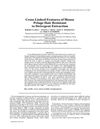TLDR Human hair contains many proteins, with some being highly abundant and modified.
The study conducted a proteome analysis of the human hair shaft using two-dimensional LC-MS/MS, identifying 343 proteins. Among these, 70 proteins, including keratin intermediate filament proteins, were found in high abundance and were largely extractable with denaturants. Over 300 proteins were part of an insoluble complex formed by transglutaminase cross-linking. The proteins identified were distributed across various cellular locations, including the cytoplasm, nucleus, mitochondria, ribosome, and plasma membrane. The study provided insights into the ultrastructural features of mature hair, noting posttranslational modifications such as methylation, dimethylation, and evidence of ubiquitination in hair proteins.
686 citations
,
February 2002 in “Current Opinion in Cell Biology” 235 citations
,
July 1999 in “Journal of biological chemistry/The Journal of biological chemistry” Human hair is made up of different keratins, some strong and some weak, with specific types appearing at various stages of hair growth.
 15 citations
,
February 1999 in “The anatomical record”
15 citations
,
February 1999 in “The anatomical record” Some mutant mice have hair with abnormal cross-linking, mainly in the cuticle, not affecting other hair parts.
228 citations
,
January 1997 in “Birkhäuser Basel eBooks” 175 citations
,
January 1995 in “Birkhäuser Basel eBooks” 
The book is a detailed guide on hair growth issues and treatments, recommended for specialists and hospital libraries.
43 citations
,
July 1994 in “Journal of Cell Science” 116 citations
,
April 1986 in “The journal of cell biology/The Journal of cell biology” Trichohyalin is a protein in hair follicles that helps form hair filaments.
59 citations
,
July 1972 in “Biochemistry” Transamidases help form strong crosslinks in hair proteins, crucial for hair strength.
686 citations
,
February 2002 in “Current Opinion in Cell Biology”

